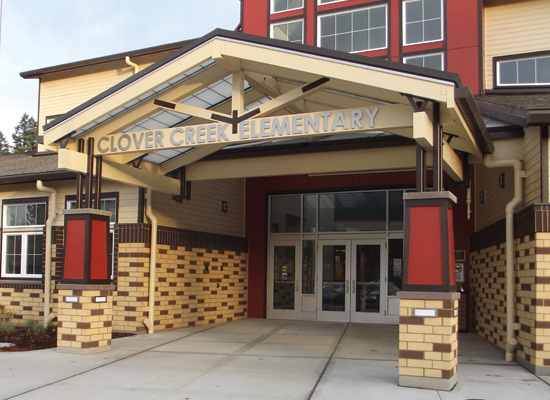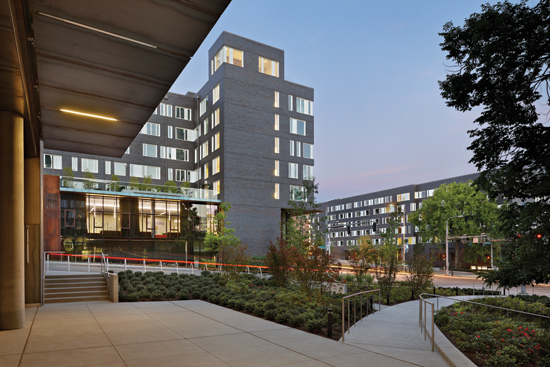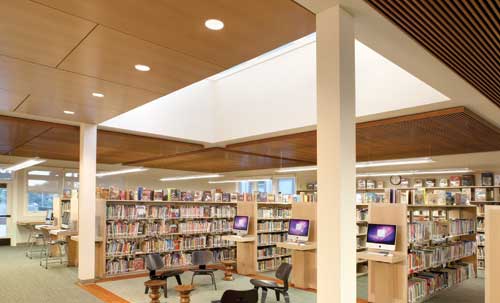Wood Scores A+ for Schools & Student Housing
| CLOVER CREEK ELEMENTARY SCHOOL | ||
|
||
|
Location: Tacoma, WA The Bethel School District (BSD) in Washington State uses wood framing to reduce construction and operational energy costs, leaving more money for student education. Like school districts across America, BSD has a limited budget to spend on facilities. “If I can save money by using wood framing in our new building projects, I can use that money to buy more expensive but more efficient mechanical or lighting systems,” said James Hansen, Director of Construction and Planning. “And that, in the long term, helps us save money in the general fund. Our decision to improve energy efficiency in our schools wasn’t driven by a commitment to the environment, although that’s an added benefit. It was a very practical decision.” The use of wood allows BSD to maximize the use of inexpensive batt insulation, which helps to improve energy efficiency. “Why put just six inches of insulation into a 12-inch cavity?” asked Wayne Lerch, Principal with Erickson McGovern Architects, a Tacoma, Washington-based firm that has designed a number of BSD facilities. “Batt insulation is a cost-effective way to increase energy efficiency just by filling the spaces, and we take advantage of that with wood framing.” BSD reports construction costs per square foot that are much lower than the average for other schools in the region, an achievement Hansen credits to the use of wood. Clover Creek Elementary, which replaced an older school on the site, was built at a cost of $197.70 per square foot—a savings of more than $50 per square foot over the average construction cost of an elementary school in Western Washington. |
| UNIVERSITY OF WASHINGTON WEST CAMPUS STUDENT HOUSING – PHASE 1 | ||
|
||
|
Location: Seattle, WA In 2012, the University of Washington completed a $109-million,* five-building construction project known as West Campus Student Housing – Phase I. The project was designed by Mahlum Architects, which was asked to create a community that could be built within a tight budget, yet provide iconic identity, exceptional energy efficiency and integrated sustainability. With this in mind, Mahlum worked with engineers at Coughlin Porter Lundeen to make the most of the urban campus location, designing each of the buildings with five stories of light-frame wood construction over a two-story concrete podium. According to project architect Anne Schopf, the concept of a five-story wood structure is nothing new to Mahlum. “We’ve been using wood framing for a long time and for a number of reasons. For example, our decision to use wood allows us to transfer costs. These residence halls have an extremely high quality skin with a high functioning structure that meets all the needs and requirements of the project without sinking undue money into the structure itself. That wood-framed structure is doing everything it needs to do without taking an unduly large percentage of the budget to do it.” Wood framing also provided design flexibility, increased speed of construction, cut overall carbon emissions, and utilized local materials and a skilled labor force. Careful attention to detailing created an air- and water-tight, thermally efficient building envelope, providing long-term durability and energy efficiency. The five buildings are testament to the fact that wood construction can not only save time and money, but also create elegant, durable, urban structures that contribute positively to city and campus vitality. There are a number of additional student housing projects under development at the university, and all will be built with wood. *Construction cost |
| POLYTECHNIC SCHOOL | ||
|
||
|
Location: Pasadena, California This innovative private K-12 school is a podium design, with two stories of wood-frame construction on a concrete “podium” deck. In addition to its use as a structural material, wood provides a dramatic finish throughout the school. “Wood siding and exposed wood rafters on the building’s exterior are an extension of the adjacent Craftsman-style buildings on campus, evoking a familiar, comfortable feeling for students, and stained wood within the library interior provides a warmth that can only be achieved through the use of natural materials,” says Kyle Peterson, Architect, LEED AP BD+C. While wood’s natural beauty was an asset, Peterson says it also offered cost advantages. “Steel-framed buildings were considered, but wood-framed construction was estimated to cost $50–$75 less per square foot than a comparable steel-frame project. And thanks to Benchmark Contractor Inc.’s familiarity with this type of project, the speed of construction was amazing. The project was delivered to the owner nearly five months ahead of schedule.” Given the proximity of the parking garage to the school, sound transmission was a key consideration. Per code, the underside of the floor joists of the second floor of the classroom building was required to be fire protected with gypsum board. Sound insulation within the floor joist cavity was used both to limit sound and avoid the need for additional sprinkler heads within what is considered an enclosed attic. Lastly, lightweight concrete was applied to the second floor plywood deck to absorb sound and reduce sound transfer. “Podium construction is typically used on high-density, multi-use residential projects, but considering the cost and availability of land, this model applies to educational projects very well, and will be seen with increasing frequency in the future,” says Peterson. |












